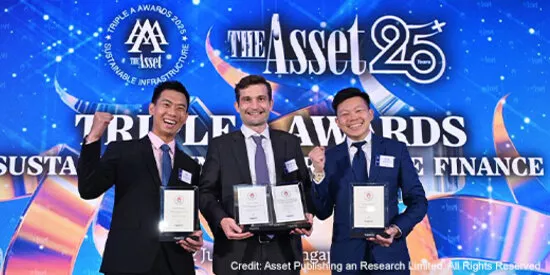
How offshore wind can scale up South-East Asia’s energy transition
South-East Asia’s transition away from fossil fuels will require investment in renewable energy on an unprecedented scale.
To keep pace with its economic growth, the Asean region will need to install another 2,770 to 3,400 gigawatts (GW) of renewable power capacity to reach net zero by 2050, according to the International Renewable Energy Agency (Irena). To put that in context, global renewable capacity today is only 2,352 GW. It’s an enormous gap to fill. The scale of this challenge, however, is also an opportunity to develop new, sustainable energy sources that will drive growth at the same time as cutting emissions.
Offshore wind is perhaps the most scalable clean energy technology in much of South-east Asia, especially in countries with long coastlines and where the available land for utility-scale solar installations is relatively scarce. From a generation perspective, offshore wind energy tends to be more stable than onshore wind or solar power, while the offshore location avoids disrupting other land users.
The Philippines alone has 178 GW of technical offshore wind potential, according to a 2022 World Bank report. In a high-growth scenario, the country could generate 21 GW from offshore wind by 2040, compared to just 0.44 GW of installed onshore wind as of 2020.
Vietnam is closer to scaling up its offshore wind power industry, having already launched some pilot projects. According to a 2021 study by the International Finance Corporation and World Bank, offshore wind could supply 12 per cent of Vietnam’s electricity by 2035.
With a track record for offshore wind already in place in North Asia, the time is ripe for this technology to play its part in South-east Asia’s energy transition.
We see three ingredients to establishing offshore wind as a significant part of the region’s future energy mix.
A scalable ecosystem
The scale of offshore wind projects makes them attractive to investors. While maintenance and installation at sea can be costly, the cost synergies of a major offshore wind farm allow the technology to be competitive. Since the first offshore wind projects were financed over 10 years ago, equity sponsors have built a track record of solid and stable returns, encouraging them to support new projects.
This track record is already apparent in Asia. The first commercial-scale offshore wind project in Asia-Pacific, Formosa 1 in Taiwan, reached financial close in 2018, and a number of other mega projects have followed in North Asia. Societe Generale has been involved as financial advisor or leading debt provider on the capital raising for 14 offshore wind projects in North Asia, across Japan, Taiwan and South Korea.
As a result, global renewable energy specialists have now established a strong pipeline of projects in North Asia and are looking to bring this expertise to the rest of the region.
Danish wind farm specialist Orsted is looking to develop several gigawatts of offshore wind projects in Vietnam by 2030, while Copenhagen Infrastructure Partners, Singapore-based Nexif Energy and others are also involved in the sector.
Asia’s growing offshore wind ecosystem can also benefit South-east Asia. Ports in southern Taiwan, for example, may be able to support turbines installed off the north of the Philippines, less than 250 km away.
South-east Asia is also rich in specialist marine contractors, which can be adapted to installing and maintaining turbines, and sophisticated port infrastructure will be important for ongoing maintenance requirements. Already we have seen some of Singapore’s top marine businesses investing in offshore wind vessels and related electrical equipment.
Financial support
Access to finance will also be essential, and here the winds are blowing in South-east Asia’s favour. Banks and institutional investors have shown strong interest in renewable energy projects across the region, and the investment community in South-east Asia is growing rapidly.
Singapore, as a regional investment hub, can bring additional expertise from a diverse range of financing partners, from multilateral development banks to family offices. One example is Singapore-based Clime Capital, which manages clean energy investments on behalf of a group of philanthropic investors, and is supporting a feasibility study aiming to develop 3 GW of offshore wind power in the Philippines.
Investment funds can also support individual projects as anchor investors alongside the main contractor. All this adds financing capacity, spreads the burden beyond the public sector, and allows equity sponsors to recycle their capital.
Appetite for innovation
The final ingredient is technology. South-east Asia has shown its ability to embrace innovative zero-emissions technologies, such as floating solar, and recent advances in wind turbines give countries in the region an opportunity to effectively leapfrog other markets by selecting the most efficient modern solutions.
Floating offshore wind is the next frontier for the clean energy sector. As the name suggests, the turbines float like a buoy on the ocean’s surface, which means they can be placed in much deeper waters than a conventional fixed-bottom turbine. This allows offshore wind farms to be located in areas with faster, steadier winds and mitigates concerns around disruption to near-shore marine traffic.
Societe Generale helped proved the concept in 2022 with the successful financing of a first commercial project in France, while a number of industry-scale floating offshore wind projects are under preparation in North Asia.
Every energy project is different, and all are complex. But South-east Asia’s entrepreneurial spirit, its access to finance and the scale of the opportunity are strong foundations for the energy transition.
With the right conditions in place, the offshore wind sector can help Asia chart a course to a low-carbon future.
The writer is Managing Director, Energy+ Group, Asia-Pacific, Societe Generale.
This article was originally published by the Business Times.

日本のエネルギー・トランジションに向けて「東」と「西」を結ぶ
昨年ソシエテ・ジェネラルがグローバルロードショーの一環として開催した「ポジティブ・インパクト・デー」の東京会場では、日本の脱炭素化政策と国際的なパートナーとしての役割について、最新の動向を踏まえた活発な議論がなされました。

2024年第4四半期および2024年通期決算
パリ、2025年2月6日




